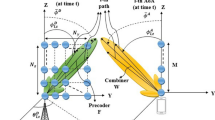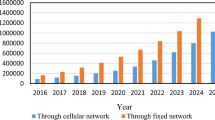Abstract
The requirement to suppress narrowband interferences in CDMA communications stems from the overlay concept, i.e., coexistence of different types of signals in the same frequency band. The conventional approach to rejecting the narrowband interferences has been to whiten the received signal containing the interference, prior to spread spectrum demodulation. In this paper, it is proposed to achieve the interference rejection through spatial processing. The main benefit of this approach is its robustness with respect to the interference bandwidth. Stepping up from single domain spatial processing to space-time processing provides degrees of freedom for both overlay interference cancellation and diversity combining. Two space-time architectures, cascade and joint-domain, are studied and compared to a Rake receiver preceded by a whitening filter. Main contributions of the paper are the development of analytical expressions of (1) the efficiency of each method, (2) the p.d.f.'s of the output SNR in a Rayleigh fading environment, and (3) the error probability associated with each method. The analysis therein demonstrates that the joint-domain architecture outperforms the cascade configuration, which in turn is superior to the whitening filter-Rake combination.
Similar content being viewed by others
References
L.B. Milstein et al., “On the Feasibility of a CDMA Overlay for Personal Communications Networks”, IEEE Journal on Selected Areas in Communications, Vol. 10, No.4, pp. 655–668, 1992.
J. Wang and L.B. Milstein, “CDMA Overlay Situations for Microcellular Mobile Communications”, IEEE Trans. Commun., Vol. 43, No.2/3/4, pp. 603–614, 1995.
J.W. Ketchum and J.G. Proakis, “Adaptive Algorithms for Estimating and Suppressing Narrow-Band Interference in PN Spread-Spectrum Systems”, IEEE Trans. Commun., Vol. 30, pp. 913–923, 1982.
L.B. Milstein, “Interference Rejection Techniques in Spread Spectrum Communications”, Proceedings of the IEEE, Vol. 76, pp. 657–671, 1988.
R.A. Iltis, “A GLRT-Based Spread-Spectrum Receiver for Joint Channel Estimation and Interference Suppression”, IEEE Trans. Commun., Vol. COM-37, pp. 277–288, 1989.
R. Vijayan and H.V. Poor, “Nonlinear Techniques for Interference Suppression in Spread-Spectrum Systems”, IEEE Trans. Commun., Vol. 38, pp. 1060–1065, 1990.
L. Rusch and H.V. Poor, “Multiuser Detection Techniques for Narrowband Interference Suppression in Spread Spectrum Communications”, IEEE Trans. Commun., Vol. 43, pp. 1725–1737, 1995.
J.H. Winters, J. Salz, and R.D. Gitlin, “The Impact of Antenna Diversity on the Capacity of Wireless Communications Systems”, IEEE Trans. Commun., Vol. 42, pp. 1740–1751, 1994.
A.F. Naguib and A. Paulraj, “Performance of CDMA Cellular Networks with Base-Station Antenna Arrays”, in Mobile Communications: Advanced Systems and Components, 1994 International Zurich Seminar on Digital Communications Proceedings, Zurich, Switzerland, pp. 87–100, 1994.
Y. Yoon, R. Kohno and H. Imai, “A Spread-Spectrum Multiaccess System with Cochannel Interference for Multipath Fading Channels”, IEEE Journal on Selected Areas in Communications, Vol. 11, pp. 1067–1075, 1993.
X. Wu and A. Haimovich, “Space-Time Optimum Combining for CDMA Communications”, The special Issue on “Signal Separation and Interference Cancelation for Personal, Indoor and Mobile Radio Communications (PIMRC)” Wireless Personal Communications, Vol. 3, pp. 73–89, 1996.
A. Shah and A.M. Haimovich, “Space-Time Optimum Combining for CDMA Overlay for Personal Communication Systems”, Wireless Personal Communications, 1996. Accepted for publication.
V. Bogachev and I. Kiselev, “Optimum Combining of Signals in Space-Diversity Reception”, Telecommun. Radio Eng., Vol. 34/35, pp. 83–85, 1980.
S. Haykin, Adaptive Filter Theory, Prentice Hall: Englwood Cliffs, NJ, third ed., 1996.
D. Slepian and H.O. Pollak, “Prolate Spheroidal Wave Functions Fourier Analysis and Uncertainty – III: The Dimension of the Space of Essentially Timeand BandLimited Signals”, The Bell System Technical Journal, pp. 1295–1336, 1962.
J. Proakis, Digital Communications 3/e, McGrawHill: New York, 1995.
J. DiFranco and W. Rubin, Radar Detection, Prentice Hall: Englewood Cliffs, NJ, 1968.
M. Abramowitz and I.A. Stegun, Handbook of Mathematical Functions (tenth printing), National Bureau of Standards: Washington, DC, 1972.
J. Seaborn, Hypergeometric Functions and Their Applications, SpringerVerlag: New York, 1991.
H. Exton, Handbook of Hypergeometric Integrals, Ellis Horwood Limited: Chichester, UK, 1978.
Author information
Authors and Affiliations
Rights and permissions
About this article
Cite this article
Haimovich, A., Shah, A. The Performance of Space-Time Processing for Suppressing Narrowband Interference in CDMA Communications. Wireless Personal Communications 7, 233–255 (1998). https://doi.org/10.1023/A:1008814711835
Issue Date:
DOI: https://doi.org/10.1023/A:1008814711835




